MARIANI’S
August
27, 2006
NEWSLETTER
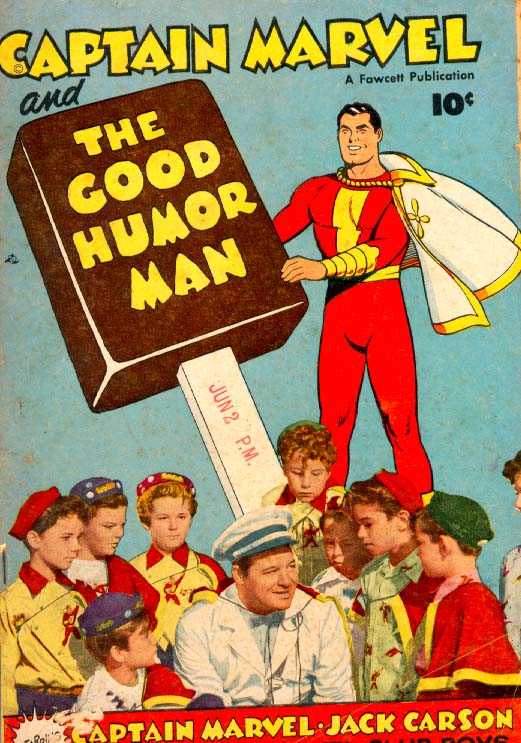
Comic book tie-in with the movie "The
Good Humor Man" (1950)
UPDATE: To
go to my web site, in which I will update food
&
travel information and help link readers to other first-rate travel
& food sites, click on: home page
ACCESS TO
ARCHIVE: Readers may now access
an
Archive of all past newsletters--each annotated--dating back to July,
2003, by simply clicking on www.johnmariani.com/archive
.
NEW
FEATURE! You
may now subscribe anyone you wish
to this newsletter by
clicking here.
In
This Issue
NEW YORK CORNER: Chinatown Brasserie by John Mariani
QUICK BYTES
~~~~~~~~~~~~~~~~~~~~~~~~~~~~~~~~~
LIVING HIGH IN PUERTA VALLARTA
by Edward Brivio
Photography by
Robert Pirillo
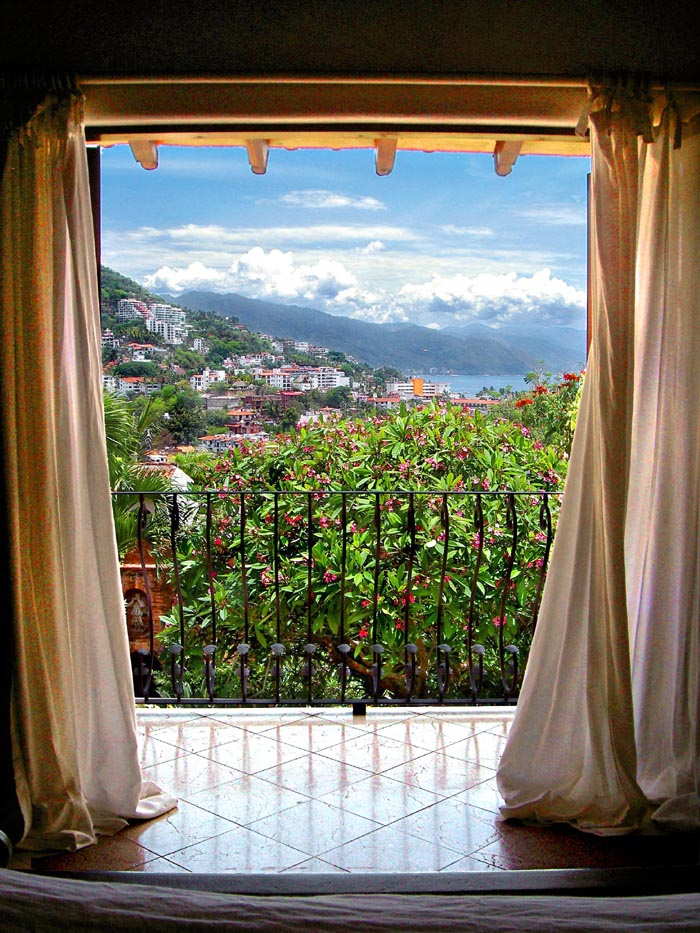 I must now
add to my personal short-list of
fabulous places the Hacienda San Angel
I must now
add to my personal short-list of
fabulous places the Hacienda San Angel One of the wonders here is that although you're completely removed from its noise and traffic, the center of town is less than a five-minute walk away, albeit up and down well-graded stairs in lieu of sidewalks. An unassuming front door takes you from the steep, dusty, cobblestone street and your overheated taxi into a Moorish vision of paradise: an atrium-like patio, with stone floors, azulejo-covered walls, overhanging greenery, and the soft splash of a fountain. Once past the patio, which serves for reception, as well as for pre-dinner cocktails, you enter a lush tree-and flower-filled garden, with flights of stairs leading off to the right and left. The hotel proper sprawls across a series of terraces, affording, as you ascend, more and more unencumbered views of Banderas Bay, the town of PV, Carlotta's crown atop the bell tower of Nuestra Señora de Guadalupe church, and even the foothills of the Sierra Nevadas behind.
Hanging ferns, date-palm fronds, and flourishing vines soften the contours of crisp, white stucco walls, while flowering bougainvillea add bright splashes of color to cool terra cotta floors, graceful arcades, and simple Doric columns gleaming in the sun. Lovely ironwork railings and stone balustrades punctuate the space. Three pools beckon (right), promising relief from the afternoon heat, while deep eaves provide welcome shade.

Within the guest rooms and without, all is set with beautiful 18th and 19th century Mexican and European furniture--armoires, massive, intricately carved beds, and ornate cassones vie with gilt-framed mirrors, crystal chandeliers and colorful Persian carpets to delight the eye. Even more beautiful museum-quality artifacts (many, in fact, purchased from a Mexican museum about to be closed) complete the magic.
Appropriately, angels and archangels form the main theme, with saints and apostles and polychrome and gilt statues, most from the early 19th century and before, in all the sitting rooms. Dark, moody Colonial oil-paintings in their original frames and bas-reliefs in stone and wood, elaborate wooden doors rescued from historic haciendas on the verge of demolition are everywhere on the property. Even a few folk-art pieces--an old, red horse-wagon from San Miguel de Allende doubling as a kitchen table, a larger than life-size, beautifully-rendered sheet-iron rooster, a handful of colorful, vintage carrousel horses, a miner's pot--are included, as are a scattering of ceramics, both European and indigenous.
Brochures in the rooms include a print-out identifying most of the major pieces and their provenances, but these are not the stuffy, hushed rooms of a fine museum, but bright, airy, informal spaces, open to the elements, overlooking flowering tree-tops, deep-blue, rectangular pools, the wide, placid arc of the bay, and the sky beyond.
The sound of running water is everywhere. Overstuffed sofas and armchairs, upholstered in easy-to-care-for white duck, create a laid-back, beach-house ambiance, while linen sheets and duvets, luxurious limestone bathrooms, ubiquitous phones that never ring, but only serve for summoning snacks or beverages chaise-side, and a large, friendly, obviously contented staff not only provides a constant temptation to indolence but also reinforces the impression of being a welcome guest in someone's exquisite, lovingly hand-crafted home.
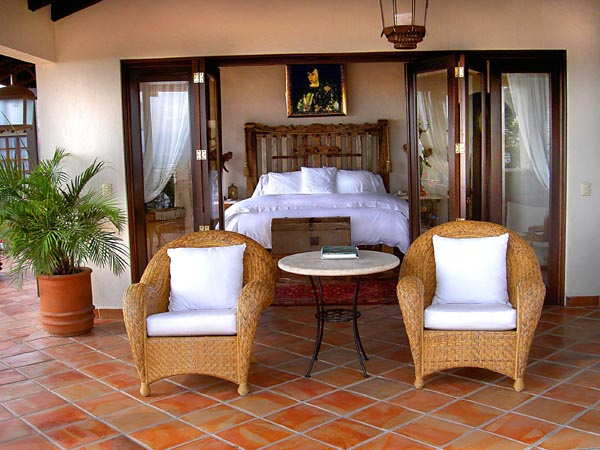 Deciding where to dine is one of the Hacienda's
charming dilemmas. Meals may be enjoyed either in the "main"
dining-room (below), inside or
out, on an upper terrace facing one of
the pools
with an
Amalfi-coast-worthy view of the Bay. Or you can be served on your own
private
terrace (most suites, like the one at left, have them), or in one of
the other various dining
areas,
again either alfresco or not, scattered about the place, with tables
and chairs
ready to be set with fine china, crystal, silverware, and napery. The
waiters
here are remarkably adept at mounting stairs with heavily-laden trays,
even, as
it turned out, while working
with umbrellas in thunderous
downpours.
Deciding where to dine is one of the Hacienda's
charming dilemmas. Meals may be enjoyed either in the "main"
dining-room (below), inside or
out, on an upper terrace facing one of
the pools
with an
Amalfi-coast-worthy view of the Bay. Or you can be served on your own
private
terrace (most suites, like the one at left, have them), or in one of
the other various dining
areas,
again either alfresco or not, scattered about the place, with tables
and chairs
ready to be set with fine china, crystal, silverware, and napery. The
waiters
here are remarkably adept at mounting stairs with heavily-laden trays,
even, as
it turned out, while working
with umbrellas in thunderous
downpours. The cooking here is on a par with the surroundings. The kitchen prepares dishes familiar to its international clientele--steak, ravioli, grilled filet of fish, soups and salads--all the while using local ingredients and spices, especially
Ceviche is the perfect hot-weather appetizer, especially the Hacienda's version, made with butterflied shrimp and blanched octopus, red onions, habanero peppers, and cilantro in a lime juice marinade. The shrimp were fully "cooked," that is, cured in the marinade, the octopus had just the right tender bite, and the hint of heat from the habaneros made it all the more refreshing. Order the fried calamari (lightly seasoned with chilies and lime) early on in your stay and you'll want it often. The perfectly-fried, crispy little nuggets--each just about one good crunch--arrive in an upright seaweed cone, along with a white wine-mustard sauce and a spicy red cocktail sauce.
The Hacienda's gazpacho, once again, was just about as good as this ubiquitous dish gets, a beautiful, thin, brick-red colored liquid, vibrant with tomato, bell pepper, celery and cucumber flavors, and garnished with a tiny dice of cucumber. With a couple of ice cubes added to the bowl, it took me back to my first encounter with gazpacho, on a steamy August day in pre-air-conditioned Seville, when it provided momentary relief from the heat.
Don't pass up the hot soups either, whether the shrimp and coconut, a satiny bisque powered by a rich fumet, nicely flavored with coconut and Mexican spices, or the hearty Chef's Special soup, a large bowl of creamy, thyme-perfumed chowder, chock-a-block with shrimp, scallops, octopus and chunks of fish, each different fish treated with respect. It's more stew than soup. Classic Caesar salad is another must-try, either on its own as an appetizer, or with grilled chicken or shrimp as a light luncheon entree. It's a beautifully simple, untheatrical rendition-- just perfect for a hot June afternoon spent poolside--some leaves of immaculate romaine laid on a plate, a couple of anchovy-topped croustades rubbed with garlic, a grating of cheese, all ever so lightly dressed with a classic creamy vinaigrette. Once again, quick, light, and refreshing. The chefs here know when to pour on the flavors, and when to let freshness speak for itself.
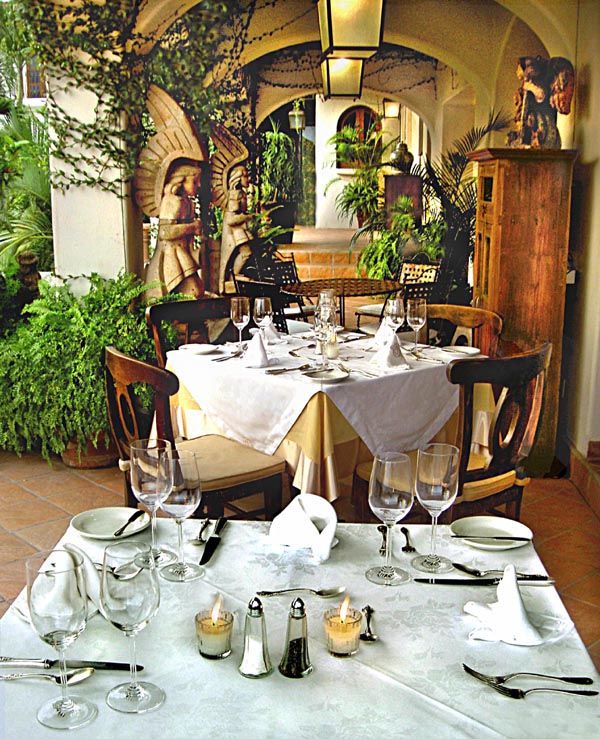
Grilled cabreria turned out to be a slice of beef tenderloin but still attached to the bone so it was fork-tender and flavorful, with ranchero-style black beans, a delicious garlic-flavored portobello, and a deep brown demi-glace sauce, flavored with guajillo, pasilla, and cascabel chilies. Al Pastor shrimp brochette consisted of perfectly grilled, slightly smoky, adobo-flavored shrimp, with a wonderful rice pilaf and a "ratatouille' of mangoes and jalapeños.
Roasted yellow-fin tuna arrived just seared as requested, topped with a lively radish vinaigrette, along with tiny sautéed new potatoes, haricots verts and grilled papaya, while Ravioli San Angel, well-made pasta stuffed with Mexican queso blanco, and topped with a good half-dozen large shrimp in a creamy garlic-tomato sauce, were rich and copious enough to satisfy the largest of appetites.
From the "All-Day" menu, which also serves for lunch, we enjoyed the Taco Trilogy, a beautiful example of something a Mexican might actually have for lunch: achiote-marinated red snapper with cilantro, chicken in red sauce, and shrimp with avocado, each on its own small corn tortilla, surrounding a mound of the Hacienda's killer guacamole and ranchero-style black beans. A bocadillo sandwich, made with Serrano ham on crusty bread, proved once again that this raw Spanish raw ham can give Italian Prosciutto a run for its money.
By the way, the rolls served with the meals --the product of a local bakery--are wonderful, as are the minty, almost medicinal mojitos. Local mariachi bands visit the hacienda nightly during the cocktail hour.
We had two delicious bottles of Chilean wine, a Miguel Torres Santa Digna Merlot 2003 Reserva (US$35), and a Château Los Boldos 2003 Cabernet Sauvignon Grand Reserve ($52), both with ripe, upfront fruit, toasty vanilla, good acidity, and a nice edge of fine tannins, the latter wine offering a bit more depth and complexity.
Appetizers and soups range from $US7-$12.50; entrees $16.50- $29.50.
One good reason to leave the Hacienda is dinner at Thierry Blouet's Café des Artistes, a complex of three eateries under one roof: TB's Bistro Gourmet, where it all started, Costantini's wine (and tapas) bar, the latest addition, and the chef's signature dining room, called Cocina de Autor (below). Cocina is the place to go in PV for a finely-tuned meal that would not be out of place, or out of the running, in any international capital of haute cuisine. "Autor" alerts diners that here the chef, as author, gives free reign to his imagination, both culinary and artistic, blending classic French, Pacific Rim, and a note here and there of Mexican.
With the stark simplicity and tonality of an abstract painting, the dining room is an elegant, understated, up-to-the-minute space, in black and white with matte, brick-red walls. Square tables and comfortable bentwood chairs, so dark brown they're almost black, white upholstery and table linens are the setting for a succession of beautiful white plates and bowls, each a different uexpected shape. In this pared-down decor, the mix of colors on the plates takes center stage, dishes in which each player has received star treatment, from the yummy, mahogany-colored caramelized onions used to garnish several plates, to an eye-catching, terrific cherry tomato marmalade, to two black as pitch, lumps of huitlacoche that looked forbidding but tasted absolutely delicious.
Sometimes Blouet separates the elements, and sets them side-by-side on the plate, with a few Miró-like dribbles of sauce; sometimes he just piles them one on top of the other in equally attractive, if more casual, less consciously picturesque compositions. Either way, everything tasted as good as it looked.
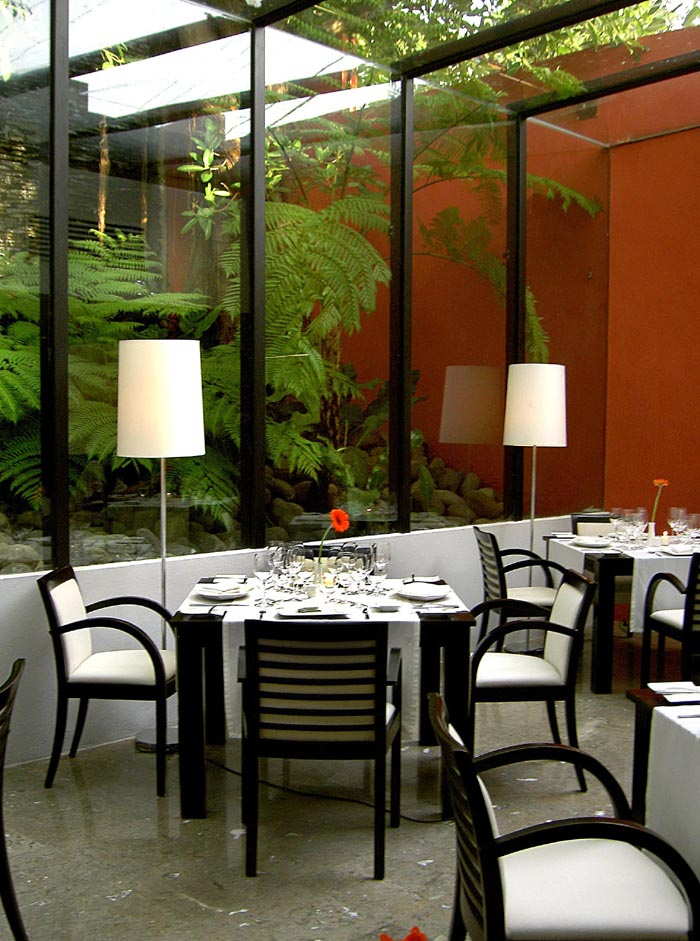 Large walls of glass separate the skylit room
from an enclosed garden that's a rain forest in miniature: large, lush
ferns
overhung by a massive banyan tree with a black granite wall-of-water
for a
backdrop, much like a nymphaeum for the 21st century. There's just
enough sky
and flora to keep diners from feeling claustrophobic.
Large walls of glass separate the skylit room
from an enclosed garden that's a rain forest in miniature: large, lush
ferns
overhung by a massive banyan tree with a black granite wall-of-water
for a
backdrop, much like a nymphaeum for the 21st century. There's just
enough sky
and flora to keep diners from feeling claustrophobic.As the waiter will inform you, the platos fuertes, or main courses, are only slightly larger than the appetizers, so one can mix and match at will. The chef recommends at least four courses, appetizer, fish, meat, dessert, and we agreed, but you could just as well order four starters, four entrees or even four desserts. Prices include tax, and bottled water--Perrier, San Pellegrino, or
I've always felt smaller was better when it comes to soft-shell crabs, and chef Blouet's, about the diameter of a coaster, have spoiled me for anything larger. Perfectly fried, even to having a hint of fried-egg from the batter, the pair disappeared all too fast, helped along by a beautiful yellow pool of a Thai mango sauce with basil and curry, and a vertical tropical salad.
A fried goat cheese roll was like the eggroll of your dreams --crisp, crunchy, and filled with good things--made even better by a drizzle of balsamic reduction, and that wonderful cherry tomato marmalade. For once, something masquerading as marmalade, that is, not made from oranges, was actually as good as the real thing.
Red snapper and tuna soon followed, the first--so fresh that even the charred skin was yummy--broiled, atop a banana and lentil salad (a combination that worked beautifully) and topped with a few of those caramelized onions, all encircled by a bright, clean orange-thyme sauce; the second, two thick collops, grilled, and served on a tasty cactus-tomato salad, alongside the huitlacoche, and a few squiggles of mole vinaigrette--a great idea.
Kobe rib-eye with bok choy and more of those jewel-like, caramelized onions, was a winner, whereas my roasted baby lamb, with potato and mushroom cake and a demi-glace-rich red wine and onion sauce was all right, but the portion was minuscule and the two nubbins of meat from the loin, overcooked.
Lemon and praline freshness lived up to its name, an ethereal, evanescent concoction of bright citrus and dark, toasted flavors, while a Stilton soufflé was just about perfect, with a good rich Stilton flavor and enough of a sweet note from the granulated sugar used to line the mold to qualify as a dessert.
A Montes Alpha 2002 Merlot ($55) from Chile filled the bill, a New World wine in the International style with plenty of upfront fruit, and mellow wood, but nice acidity as well, and just a hint of tannins to finish things off.
Three-, four-, and five-courses menus are offered, at $53, $60), and $68, respectively.
by John Mariani
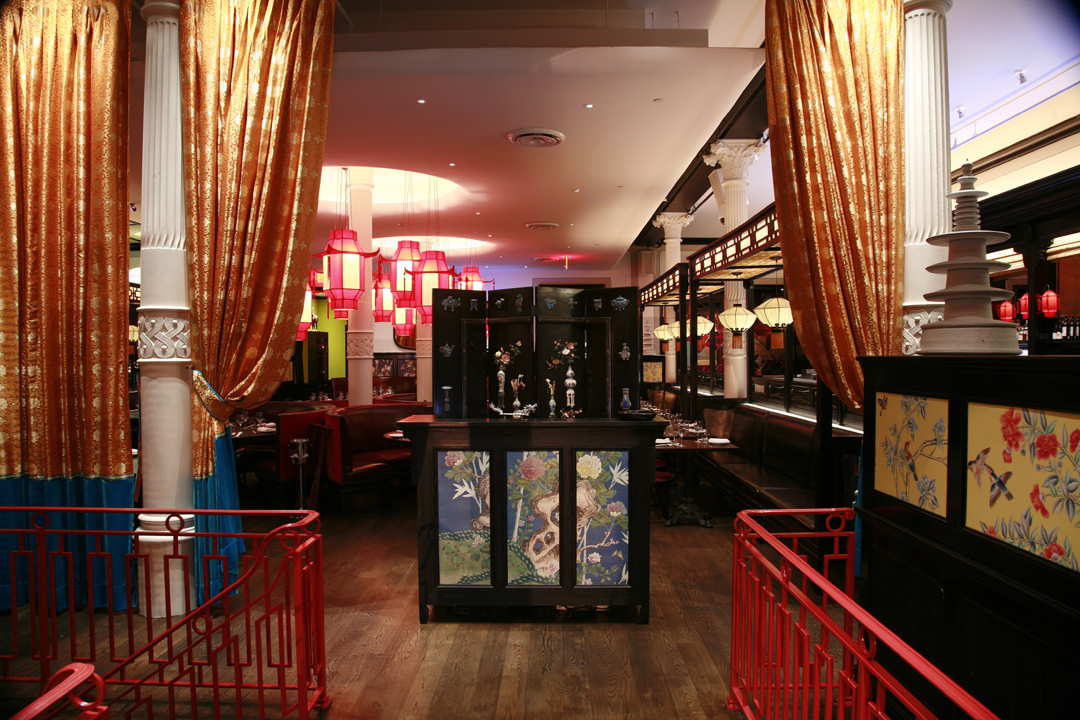
CHINATOWN
212-533-7000
www.chinatownbrasserie.com
About once a year in NYC someone decides to open a modern, upscale Chinese restaurant of a kind that proliferated in the mid-1970s when hot, spicy Hunan and Sichuan cuisine was all the rage around the U.N. neighborhood.
Jean-Georges Vongerichten did it three years ago in TriBeCa with the snooty, expensive 66, and last year Mainland opened on the upper east side without much fanfare. Chinatown Brasserie is perhaps the best effort in years, a really dazzling dining room with a fleet-footed non-Sino waitstaff, a fine winelist, and a serious focus on expertly made dim sum.
That it is not actually located in Chinatown (it's in Noho) is of no consequence, since Chinatown has fallen on hard times, mostly through its own stubborn efforts to treat non-Asian customers with offhanded service, menus that bear little resemblance to what they serve their Chinese-speaking clientele, and a refusal to make access to its labyrinthine streets any easier than it was fifty years ago. Going for dim sum in Chinatown is fun sometimes, but going for dim sum at Chinatown Brasserie is really a treat.
Owners Joshua Pickard and John McDonald, who also own the estimable Lever House Restaurant and Lure Fishbar, together with Chef
 The design statement says it is "conceptualized around
the experience of first-generation Chinese émigrés and
intended to reflect elements of Chinese design, American Chinese
culture and
European brasserie tradition," with decorative
items such as cork sculptures, lush silk tapestries and painted screens
with
antique mirrors and vintage photographs. There are
also expanses of floor-to-ceiling Chinese silk damask
curtains, banquettes modeled after Imperial beds, 10-foot tall
silk canopies, huge silk lanterns on the ceiling, two large paintings
by artist Robert
Kushner, and ceramic white Sutra holders by Peter Lane. A “lily pad”
landing on a koi pond leads downstairs, where there are
semi-private booths.
The design statement says it is "conceptualized around
the experience of first-generation Chinese émigrés and
intended to reflect elements of Chinese design, American Chinese
culture and
European brasserie tradition," with decorative
items such as cork sculptures, lush silk tapestries and painted screens
with
antique mirrors and vintage photographs. There are
also expanses of floor-to-ceiling Chinese silk damask
curtains, banquettes modeled after Imperial beds, 10-foot tall
silk canopies, huge silk lanterns on the ceiling, two large paintings
by artist Robert
Kushner, and ceramic white Sutra holders by Peter Lane. A “lily pad”
landing on a koi pond leads downstairs, where there are
semi-private booths. That bar is where they mix up a slew of signature cocktails with goofily exotic names like Ginger Dragon and Green Tea Collins, and the winelist has about 130 selections, well chosen to go with spicy Chinese food (though I can't imagine why anyone would order a Scopetone Brunello di Montalcino 2000 [$74] or a Francois Jobard Meursault "en la barre" 2002 [$124] with such food). Much better was a spice-rich Rostaing Syrah "Les Lezardes" 2003 ($66) I heartily enjoyed.
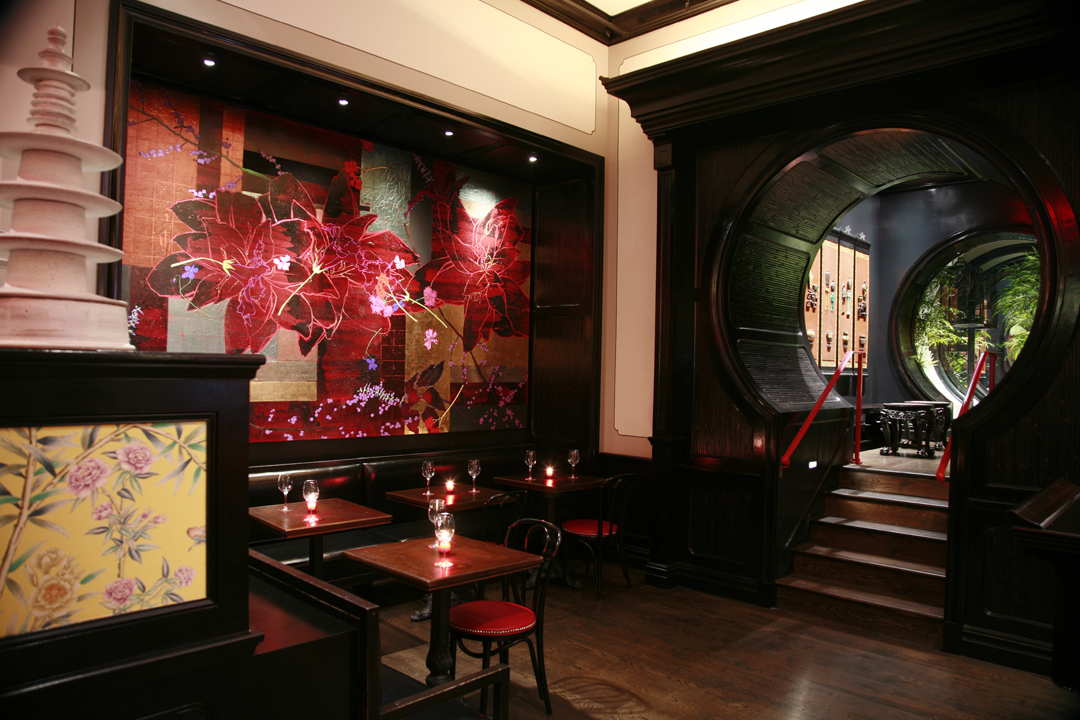 As several of my reviewing colleagues have
already mentioned, Chinatown Brasserie is at its best with dim sum (below), which I too found delicate,
extremely juicy, and nicely varied, with steamed varieties like
four-mushroom with corn, and crabmeat and pork, pan-fried tempura
shrimp stuffed green chilies, and Malaysian eggplant and shrimp.
The portions offer four pieces, and range from $8-$20, which gets a
little steep. You won't find anything too unusual among the dim
sum, as you do in Chinatown, but they are well made and prettily set in
bamboo steamers at your table.
As several of my reviewing colleagues have
already mentioned, Chinatown Brasserie is at its best with dim sum (below), which I too found delicate,
extremely juicy, and nicely varied, with steamed varieties like
four-mushroom with corn, and crabmeat and pork, pan-fried tempura
shrimp stuffed green chilies, and Malaysian eggplant and shrimp.
The portions offer four pieces, and range from $8-$20, which gets a
little steep. You won't find anything too unusual among the dim
sum, as you do in Chinatown, but they are well made and prettily set in
bamboo steamers at your table.I also recommend the Peking duck (below, left), which has the appropriately crisp skin served with the lush meat, very light, thin pancakes, scallions, and hoisin sauce, and four people should be happy with the portion ($48). I am particularly happy that the bird arrives already sliced from the kitchen so that you can make your own packet rather than wait interminably for a waiter to do it for everyone at the table, with the duck invariably getting cold.
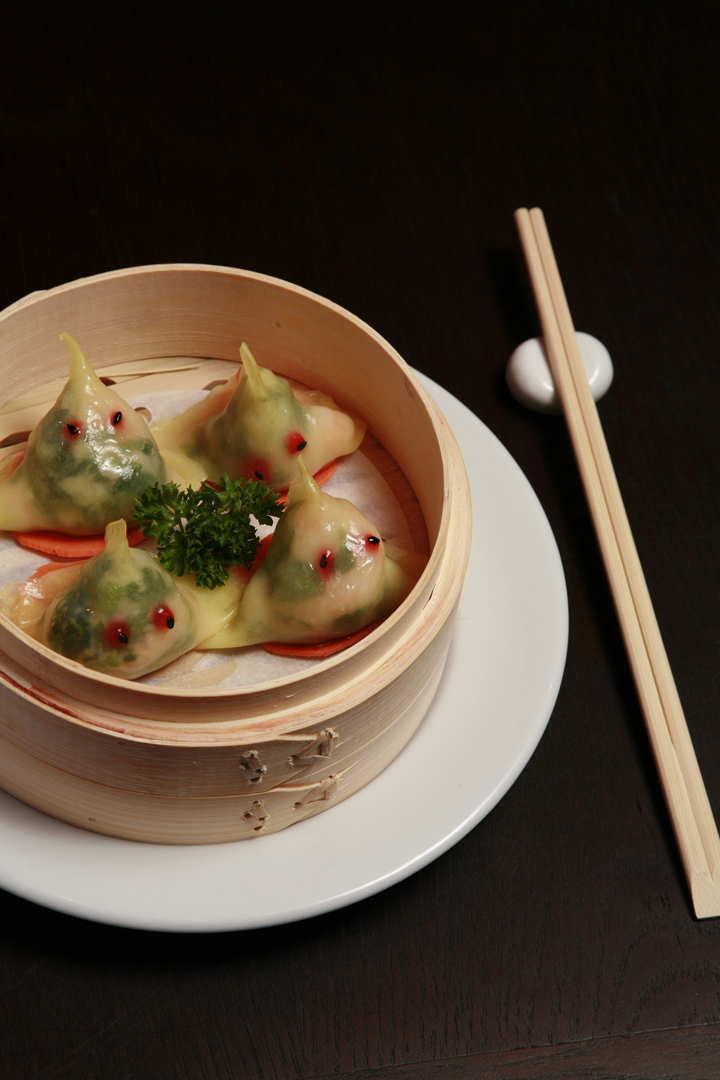
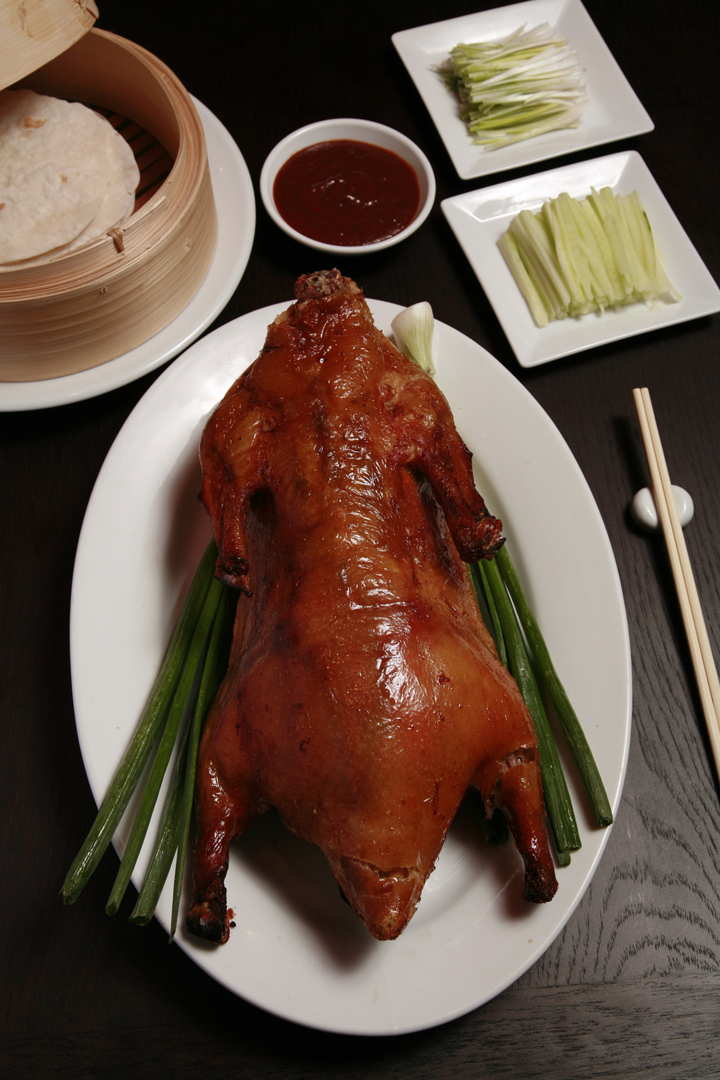 There's no quibbling about the freshness and
quality of the fish at Chinatown Brasserie, like the steamed branzino with ginger,
scallion, and pickled plum, and most of the other dishes are
commendable, with the possible exception of that silly cliché,
General Tso's chicken, which had little more than texture and an oily
residue on the palate. The only real problem with the menu at
Chinatown Brasserie is that it is wholly predictable, mostly
refined takes on the kind of items you'll find at
just about any Chinese restaurant in a shopping strip anywhere in
the USA.
There's no quibbling about the freshness and
quality of the fish at Chinatown Brasserie, like the steamed branzino with ginger,
scallion, and pickled plum, and most of the other dishes are
commendable, with the possible exception of that silly cliché,
General Tso's chicken, which had little more than texture and an oily
residue on the palate. The only real problem with the menu at
Chinatown Brasserie is that it is wholly predictable, mostly
refined takes on the kind of items you'll find at
just about any Chinese restaurant in a shopping strip anywhere in
the USA.Desserts pay no homage to China, which would be negligible if those served here were better, but none I sampled was very good, especially a poor excuse for a hot fudge sundae, albeit made with good ice cream.
There is also the niggling question of why the owners insist on piping in contemporary, bombastic music into the restaurant--have they ever asked their guests if they actually crave such a noisome intrusion? We were at first seated right under a booming speaker, then moved to a quieter table in the middle. But by 9 PM they had turned down the lights (does a place this handsome need more "mood"?) and turned the dials way up on the sound system to the point where conversation became difficult.
Nevertheless, Chinatown Brasserie has caught on for all the right reasons. And they've kept the price points in their favor, with main courses $12-$27. They've done a great deal that appeals to a great many, although trying to feed so many every lunch and dinner of every day of the week begs the question of consistency. In restaurants, unless you're accustomed to a thousand people coming for dim sum on Sunday down in Chinatown, bigger is never better, and Chinatown Brasserie is very, very big.

OH YEAH? THEN WHY'D HE NAME THEM "ANGELINA 1, 2, 3, AND 4?"
AND AFTERWARDS THE WAITERS EAT THEIR CLOTHES
 section offers staples
like longan and goji berries, fresh durian, and unsweetened cacao
nuts. In other words, raw pioneer Matt Amsden's tiny eat-in or
take-out place is for serious acolytes. The food's a masked ball
of ingredients: couscous made from grated cauliflower, mock chicken
from sunflower seeds, mashed potatoes from cauliflower and cashews,
pizza with flat onion bread, seed cheese, and tomatoes."--Restaurant
Listing in Los Angeles
Magazine (July 2006).
section offers staples
like longan and goji berries, fresh durian, and unsweetened cacao
nuts. In other words, raw pioneer Matt Amsden's tiny eat-in or
take-out place is for serious acolytes. The food's a masked ball
of ingredients: couscous made from grated cauliflower, mock chicken
from sunflower seeds, mashed potatoes from cauliflower and cashews,
pizza with flat onion bread, seed cheese, and tomatoes."--Restaurant
Listing in Los Angeles
Magazine (July 2006).QUICK BYTES
* On Sept. 14 Charlie Palmer Steak in
* Available Mon.-Fri. Sept. 18-Oct. 19, The Wauwinet in Nantucket, MA, is offering “The Cranberry Comfort” package incl. a cranberry throw; mulled cranberry cider; breakfast, cranberry massage; Crantinis in TOPPER’S bar; cranberry selections on the TOPPER’S menu, and “Taste of Nantucket” activities, incl. cranberry cooking demos with Chef David Daniels; Siasconset Natural History Excursion in The Inn's 1946 Ford Woody Wagon; Lobstering Cruise aboard The Wauwinet Lady; Great Point Wildlife Refuge Natural History Excursions by 4-Wheel Drive Vehicle; Surfcasting Expedition with Captain Rob McMullen at Great Point; Nantucket Bay Cruises; Bicycles. Packages start at $260.
MARIANI'S VIRTUAL GOURMET NEWSLETTER is published weekly. Editor/Publisher:
John Mariani. Contributing Writers: Robert Mariani, Naomi
Kooker, Kirsten Skogerson, Edward Brivio, Mort
Hochstein, Suzanne Wright. Contributing
Photographers: Galina Stepanoff-Dargery, Bobby Pirillo. Technical
Advisor: Gerry McLoughlin.
Any of John Mariani's books below
may be ordered from amazon.com by clicking on the cover image.
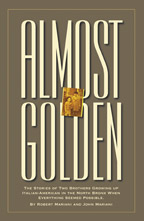 My
newest book, written with my brother Robert Mariani, is a memoir of our
years growing up in the My
newest book, written with my brother Robert Mariani, is a memoir of our
years growing up in the For those of you who don't think of the Robert and I think you'll enjoy this very personal look at our --John Mariani |
 |
 |
 |
 |
 |
 |
copyright John Mariani 2006